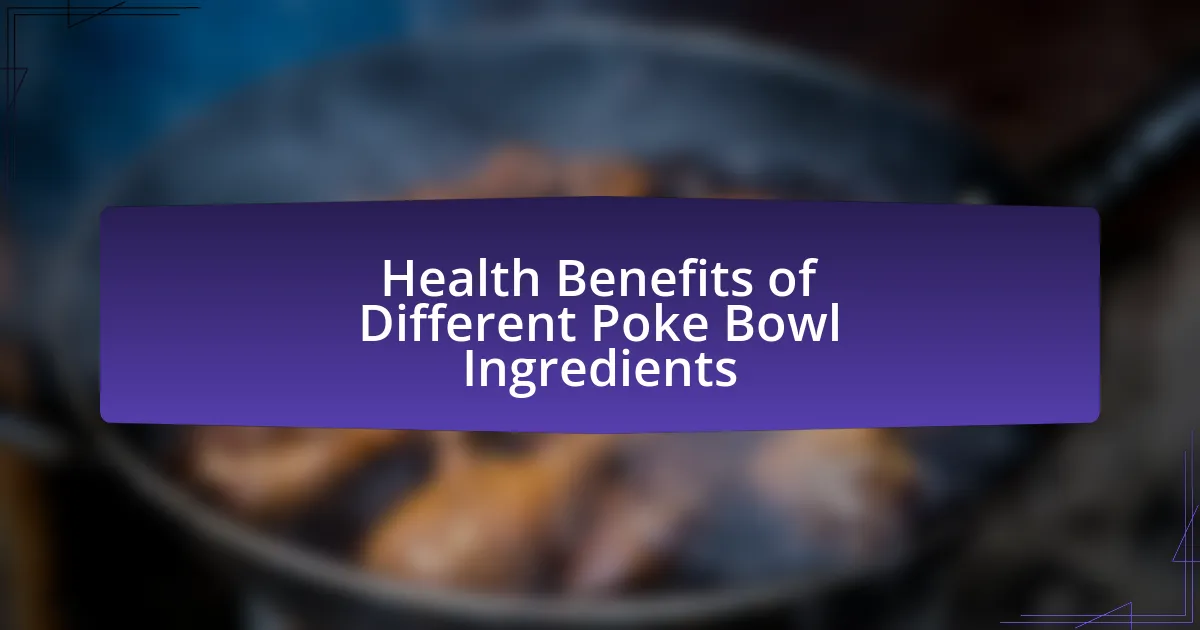Poke bowls are a nutritious meal option that combines various ingredients, each offering distinct health benefits. Key components such as raw fish provide omega-3 fatty acids that support heart health, while vegetables like seaweed and avocado contribute essential vitamins, minerals, and healthy fats. The article explores how individual ingredients enhance overall health, the importance of freshness and quality in maximizing nutritional value, and the specific roles of protein sources in muscle recovery and athletic performance. Additionally, it highlights the benefits of vegetables and toppings in improving digestion and overall well-being, along with tips for creating a balanced poke bowl.

What are the Health Benefits of Different Poke Bowl Ingredients?
Poke bowl ingredients offer various health benefits, primarily due to their nutritional profiles. For instance, raw fish, commonly used in poke bowls, is rich in omega-3 fatty acids, which support heart health and reduce inflammation. Additionally, vegetables like seaweed provide essential vitamins and minerals, including iodine and antioxidants, which promote thyroid function and overall cellular health.
Rice, often the base of poke bowls, is a source of carbohydrates that provide energy, while brown rice offers more fiber, aiding digestion. Toppings such as avocado contribute healthy fats and potassium, which are beneficial for cardiovascular health. Furthermore, ingredients like edamame are high in protein and fiber, supporting muscle repair and satiety.
Overall, the combination of these ingredients creates a balanced meal that can enhance overall health and well-being.
How do individual ingredients contribute to overall health?
Individual ingredients in poke bowls contribute to overall health by providing essential nutrients that support bodily functions. For example, salmon is rich in omega-3 fatty acids, which are known to reduce inflammation and improve heart health. Avocado offers healthy fats and fiber, promoting digestive health and satiety. Seaweed is a source of iodine and antioxidants, supporting thyroid function and protecting against oxidative stress. Additionally, vegetables like cucumbers and carrots provide vitamins and minerals, enhancing immune function and skin health. Each ingredient plays a specific role in delivering nutrients that collectively promote well-being and prevent chronic diseases.
What nutritional values do common poke bowl ingredients offer?
Common poke bowl ingredients offer a variety of nutritional values that contribute to a balanced diet. For instance, sushi-grade fish like salmon and tuna are rich in omega-3 fatty acids, which support heart health and brain function. A typical serving of salmon contains approximately 22 grams of protein and is high in vitamins B12 and D.
Brown rice, often used as a base, provides complex carbohydrates and fiber, with about 3.5 grams of fiber per cup, aiding in digestion and promoting satiety. Vegetables such as seaweed and avocado add essential nutrients; seaweed is a source of iodine and antioxidants, while avocado provides healthy monounsaturated fats and nearly 10 grams of fiber per fruit.
Toppings like edamame are high in plant-based protein, offering around 17 grams per cup, and are also a good source of folate and iron. Additionally, pickled vegetables can enhance gut health due to their probiotic content.
Overall, the combination of these ingredients in poke bowls creates a nutrient-dense meal that supports various aspects of health, including cardiovascular, digestive, and metabolic functions.
How do these ingredients support specific health goals?
Ingredients in poke bowls, such as salmon, avocado, and seaweed, support specific health goals by providing essential nutrients. Salmon is rich in omega-3 fatty acids, which promote heart health and reduce inflammation. Avocado contains healthy fats and fiber, aiding in weight management and improving digestion. Seaweed is a source of iodine and antioxidants, supporting thyroid function and overall cellular health. These ingredients collectively contribute to cardiovascular health, weight control, and enhanced metabolic function, as supported by studies highlighting the benefits of omega-3s in reducing heart disease risk and the role of fiber in digestive health.
Why is it important to choose fresh ingredients in poke bowls?
Choosing fresh ingredients in poke bowls is crucial for maximizing nutritional value and flavor. Fresh ingredients retain higher levels of vitamins, minerals, and antioxidants, which contribute to overall health. For instance, fresh fish provides essential omega-3 fatty acids that support heart health, while fresh vegetables offer dietary fiber and various micronutrients that enhance digestion and immune function. Additionally, the use of fresh ingredients minimizes the risk of foodborne illnesses, as they are less likely to harbor harmful bacteria compared to older, processed items. Therefore, selecting fresh components not only elevates the taste of poke bowls but also ensures a healthier dining experience.
What impact does freshness have on nutrient retention?
Freshness significantly enhances nutrient retention in food. When ingredients are fresh, they typically contain higher levels of vitamins, minerals, and antioxidants compared to older or processed foods. Research indicates that certain nutrients, such as vitamin C and B vitamins, degrade over time; for instance, a study published in the Journal of Agricultural and Food Chemistry found that fresh produce can lose up to 50% of its vitamin C content within a week of harvest. Therefore, consuming fresh ingredients in poke bowls maximizes the nutritional benefits, ensuring that essential nutrients are preserved and available for absorption.
How does the quality of ingredients affect health benefits?
The quality of ingredients significantly impacts health benefits by determining the nutritional value and bioavailability of essential nutrients. High-quality ingredients, such as fresh vegetables, sustainably sourced fish, and whole grains, provide higher levels of vitamins, minerals, and omega-3 fatty acids, which are crucial for overall health. For instance, studies show that fresh produce retains more nutrients compared to processed alternatives, leading to better health outcomes, including improved immune function and reduced risk of chronic diseases. Additionally, the presence of contaminants in lower-quality ingredients can negate health benefits, emphasizing the importance of ingredient quality in dietary choices.

What are the Health Benefits of Protein Sources in Poke Bowls?
Protein sources in poke bowls, such as fish, tofu, and chicken, provide essential amino acids, support muscle growth, and enhance satiety. Fish, particularly varieties like salmon and tuna, are rich in omega-3 fatty acids, which promote heart health and reduce inflammation. Tofu offers a plant-based protein option that is low in calories and high in calcium, beneficial for bone health. Chicken is a lean protein that aids in weight management and muscle repair. Studies indicate that diets high in protein can lead to improved metabolic rates and better weight control, making these protein sources in poke bowls not only nutritious but also beneficial for overall health.
What types of proteins are commonly used in poke bowls?
Commonly used proteins in poke bowls include raw fish varieties such as tuna, salmon, and octopus, as well as cooked options like shrimp and crab. Tuna and salmon are particularly popular due to their high omega-3 fatty acid content, which is beneficial for heart health. Additionally, octopus offers a unique texture and is a good source of protein. Cooked shrimp and crab provide alternative protein sources for those who prefer not to consume raw fish. These proteins not only enhance the flavor of poke bowls but also contribute to their nutritional value.
How does fish contribute to heart health?
Fish contributes to heart health primarily through its high content of omega-3 fatty acids, which are known to reduce inflammation and lower the risk of heart disease. Studies indicate that regular consumption of fish can decrease triglyceride levels, lower blood pressure, and improve overall cardiovascular function. For instance, research published in the Journal of the American College of Cardiology found that individuals who consume fish at least twice a week have a significantly lower risk of coronary heart disease compared to those who do not include fish in their diet. Additionally, the American Heart Association recommends eating fish, particularly fatty fish like salmon and mackerel, as part of a heart-healthy diet due to their beneficial effects on cholesterol levels and heart rhythm.
What are the benefits of plant-based protein options?
Plant-based protein options offer numerous health benefits, including lower cholesterol levels, reduced risk of heart disease, and improved digestive health. Research indicates that diets rich in plant-based proteins, such as legumes, nuts, and whole grains, are associated with a 25% lower risk of heart disease compared to diets high in animal proteins. Additionally, plant-based proteins are often high in fiber, which aids digestion and promotes gut health. Studies show that increased fiber intake can lead to a 30% reduction in the risk of developing type 2 diabetes. These benefits make plant-based protein options a valuable component of a healthy diet.
How do different protein sources affect muscle recovery?
Different protein sources significantly influence muscle recovery due to their varying amino acid profiles and absorption rates. For instance, whey protein is rapidly absorbed and rich in branched-chain amino acids (BCAAs), which are crucial for muscle repair and growth, making it highly effective post-exercise. In contrast, casein protein digests slowly, providing a sustained release of amino acids, which can be beneficial for overnight recovery. Plant-based proteins, such as those from legumes or quinoa, may lack certain essential amino acids but can still support recovery when consumed in a varied diet. Research indicates that a combination of protein sources can optimize recovery; a study published in the Journal of the International Society of Sports Nutrition found that mixed protein intake enhances muscle protein synthesis more effectively than single-source proteins.
What role do amino acids play in muscle repair?
Amino acids play a crucial role in muscle repair by serving as the building blocks for protein synthesis, which is essential for the recovery and growth of muscle tissue after exercise. When muscles undergo stress during physical activity, they experience micro-tears that require repair, and amino acids facilitate this process by promoting the synthesis of new proteins to rebuild the damaged fibers. Research indicates that branched-chain amino acids (BCAAs), particularly leucine, significantly stimulate muscle protein synthesis, enhancing recovery and reducing muscle soreness. A study published in the Journal of the International Society of Sports Nutrition found that supplementation with BCAAs can improve recovery outcomes in athletes, demonstrating their effectiveness in muscle repair.
How can protein sources in poke bowls enhance athletic performance?
Protein sources in poke bowls enhance athletic performance by providing essential amino acids necessary for muscle repair and growth. These amino acids support recovery after intense workouts, helping to reduce muscle soreness and improve overall strength. For instance, fish such as tuna and salmon, commonly found in poke bowls, are rich in high-quality protein and omega-3 fatty acids, which have been shown to decrease inflammation and promote muscle recovery. Research indicates that athletes consuming adequate protein post-exercise can experience improved muscle protein synthesis, leading to better performance outcomes.

What are the Health Benefits of Vegetables and Toppings in Poke Bowls?
Vegetables and toppings in poke bowls provide numerous health benefits, including enhanced nutrient intake, improved digestion, and increased antioxidant levels. Vegetables such as seaweed, cucumbers, and carrots are rich in vitamins, minerals, and dietary fiber, which support overall health and help maintain a balanced diet. For instance, seaweed is high in iodine and antioxidants, while cucumbers offer hydration and low-calorie content. Additionally, toppings like avocado contribute healthy fats, which are essential for heart health. Research indicates that a diet rich in vegetables can lower the risk of chronic diseases, including heart disease and diabetes, due to their anti-inflammatory properties and ability to regulate blood sugar levels.
Which vegetables are most commonly included in poke bowls?
The vegetables most commonly included in poke bowls are cucumber, avocado, seaweed, radish, and edamame. These vegetables are frequently chosen for their fresh flavors and nutritional benefits. For instance, cucumbers provide hydration and are low in calories, while avocados are rich in healthy fats and fiber. Seaweed is a source of vitamins and minerals, radishes add a crunchy texture and are low in calories, and edamame offers protein and fiber. This combination not only enhances the taste but also contributes to the overall health benefits of poke bowls.
What vitamins and minerals do these vegetables provide?
Vegetables commonly found in poke bowls provide a variety of essential vitamins and minerals. For example, spinach is rich in vitamin K, vitamin A, and folate, while carrots offer beta-carotene (a precursor to vitamin A), vitamin K1, and potassium. Bell peppers are high in vitamin C, vitamin A, and vitamin B6. Additionally, cucumbers provide hydration along with vitamin K and potassium. These nutrients contribute to overall health, supporting functions such as immune response, vision, and bone health.
How do toppings like seaweed and avocado contribute to health?
Seaweed and avocado contribute to health by providing essential nutrients and beneficial compounds. Seaweed is rich in vitamins A, C, E, and K, as well as minerals like iodine, calcium, and iron, which support thyroid function and overall metabolic health. Avocado is high in healthy monounsaturated fats, particularly oleic acid, which can improve heart health by reducing bad cholesterol levels. Additionally, avocados contain fiber, which aids digestion and promotes satiety. Studies have shown that incorporating these toppings into meals can enhance nutrient intake and support various health outcomes, such as improved cardiovascular health and better digestive function.
How do different toppings enhance the flavor and nutrition of poke bowls?
Different toppings enhance the flavor and nutrition of poke bowls by adding diverse textures, tastes, and essential nutrients. For instance, avocado contributes healthy fats and creaminess, while seaweed provides umami flavor and is rich in vitamins and minerals. Additionally, toppings like sesame seeds add crunch and are a source of protein and healthy fats. Vegetables such as radishes and cucumbers introduce freshness and hydration, along with vitamins A and C. The combination of these toppings not only elevates the overall taste profile but also increases the nutritional value, making poke bowls a balanced meal option.
What are the benefits of adding healthy fats to poke bowls?
Adding healthy fats to poke bowls enhances nutritional value and promotes overall health. Healthy fats, such as those from avocado, nuts, or seeds, provide essential fatty acids that support heart health, improve cholesterol levels, and aid in the absorption of fat-soluble vitamins A, D, E, and K. Research indicates that diets rich in healthy fats can reduce the risk of chronic diseases, including cardiovascular issues, by lowering inflammation and improving metabolic health. For instance, the American Heart Association emphasizes the importance of incorporating sources of unsaturated fats, which can be easily achieved by adding ingredients like avocado or sesame oil to poke bowls.
How can toppings improve digestive health?
Toppings can improve digestive health by providing essential nutrients and dietary fiber that promote gut function. For instance, toppings like avocado, seaweed, and various vegetables are rich in fiber, which aids in regular bowel movements and prevents constipation. Research indicates that a high-fiber diet can enhance gut microbiota diversity, which is crucial for overall digestive health. A study published in the journal “Nutrients” by Slavin (2013) highlights that fiber intake is linked to improved digestive health outcomes, including reduced risk of gastrointestinal disorders.
What are some tips for creating a balanced poke bowl?
To create a balanced poke bowl, include a variety of ingredients that provide essential nutrients. Start with a base of whole grains like brown rice or quinoa for fiber and complex carbohydrates. Add a protein source such as fresh fish, tofu, or chicken to supply amino acids necessary for muscle repair and growth. Incorporate a mix of colorful vegetables like cucumbers, carrots, and seaweed to enhance vitamins and minerals, which support overall health. Finally, top the bowl with healthy fats, such as avocado or sesame seeds, to promote satiety and nutrient absorption. This combination ensures a well-rounded meal that meets dietary needs and supports health.



